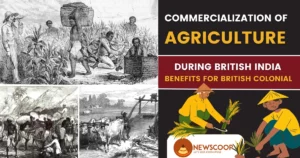Diwan-i-Kohi was an agriculture department established during the reign of Muhammad bin Tughlaq in India. The department aimed to improve cultivation and increase productivity in the Doab region, which is the fertile land between the Ganges and Yamuna rivers.
Overview of Diwan-i-Kohi
- During the reign of Muhammad bin Tughlaq, the Diwan-i-Amir Kohi was established to improve agriculture in the Doab region of India.
- The Doab region is the fertile land between the Ganges and Yamuna rivers, and it was a vital agricultural region during that time.
- The Diwan-i-Amir Kohi was a separate department that focused solely on agriculture, and its aim was to increase productivity and improve the economic condition of the farmers in the region.
- The department was headed by an official who was responsible for dividing the Doab into development blocs.
- Each bloc was headed by an official who was responsible for providing loans to farmers and engaging them in the cultivation of superior crops.
- The officials also provided guidance and training to the farmers on modern agricultural techniques and practices.
- The department also aimed to promote the cultivation of cash crops, such as sugarcane, which were in high demand in the market.
- The loans provided by the department were interest-free, and the farmers were required to repay the loans after the harvest.
- The Diwan-i-Kohi was a significant step towards improving the agricultural sector in India and increasing the productivity of the land.
- However, the department faced several challenges, such as corruption and mismanagement, which led to its eventual decline.
Main Features of Diwan-i-Kohi
1. Establishment of Diwan-i-Kohi
The Doab region was a vital agricultural region, but the farmers were facing several challenges such as low productivity and a lack of modern techniques. To address these challenges, Muhammad bin Tughlaq set up a separate agriculture department called Diwan-i-Kohi.
2. Functioning of Diwan-i-Kohi
The Diwan-i-Kohi was responsible for dividing the Doab into development blocs, each headed by an official who provided loans to farmers and engaged them in the cultivation of superior crops. The officials also provided guidance and training to the farmers on modern agricultural techniques and practices.
3. Promotion of Cash Crops
The department aimed to promote the cultivation of cash crops such as sugarcane, which were in high demand in the market. This helped to improve the economic condition of the farmers and increase their income.
4. Interest-Free Loans
The loans provided by the department were interest-free, and the farmers were required to repay the loans after the harvest. This ensured that the farmers were not burdened with high-interest rates and could repay the loans easily after the harvest.
What are the challenges faced by Diwan-i-Kohi?
- Corruption: One of the major challenges faced by Diwan-i-Kohi was corruption. The officials appointed to the department were often corrupt and misused their power for personal gain.
- Mismanagement: Another challenge faced by the department was mismanagement. The officials did not fulfill their duties properly, which led to a decline in the productivity of the land.
- Lack of funds: The department often faced a shortage of funds, which made it difficult to provide interest-free loans to farmers and implement development projects.
- Resistance from feudal lords: The feudal lords in the region often resisted the efforts of the Diwan-i-Kohi to promote cash crops and modern techniques, as they feared losing control over the land and the farmers.
- Natural disasters: The region was often prone to natural disasters such as floods and droughts, which caused significant damage to crops and infrastructure, and hindered the efforts of the department to improve agriculture.
Impact of Diwan-i-Kohi
- Introduction of modern techniques: The Diwan-i-Kohi introduced modern techniques and practices to the farmers in the Doab region, which helped to increase productivity and improve the quality of crops.
- Promotion of cash crops: The department promoted the cultivation of cash crops such as sugarcane, which were in high demand in the market. This helped to improve the economic condition of the farmers and increase their income.
- Interest-free loans: The department provided interest-free loans to the farmers, which helped to relieve their financial burden and enabled them to invest in their farms and increase their productivity.
- Improved infrastructure: The department also implemented development projects such as the construction of canals and roads, which improved the infrastructure of the region and facilitated transportation and communication.
- Increased revenue for the state: The improved productivity of the land and the promotion of cash crops helped to increase the revenue for the state, which further encouraged the government to invest in the agriculture sector.
- Inspiration for future agricultural reforms: The Diwan-i-Kohi served as an inspiration for future agricultural reforms in India, and its efforts towards improving the economic condition of farmers were recognized and appreciated.
Conclusion
The Diwan-i-Kohi was an important step towards improving agriculture in India and increasing the productivity of the land. Its focus on modern techniques, promotion of cash crops, and interest-free loans provided much-needed relief to the farmers of the Doab region.
Thank You!
Related Links:





